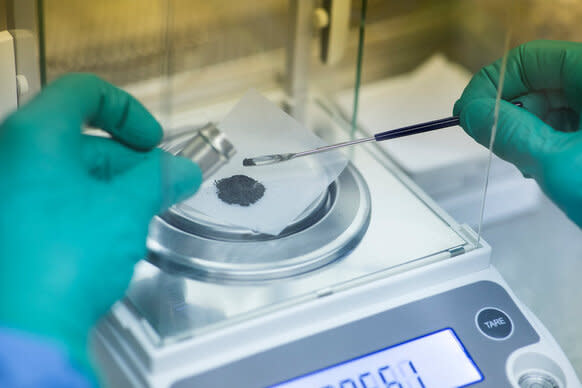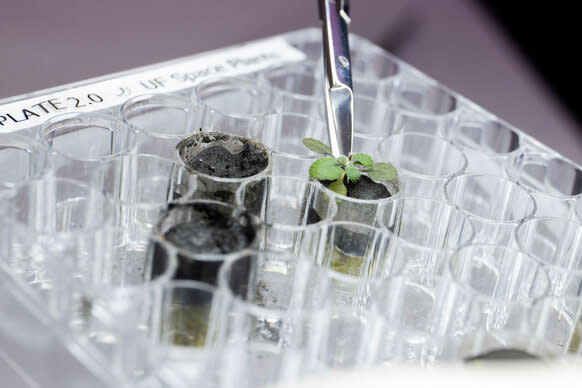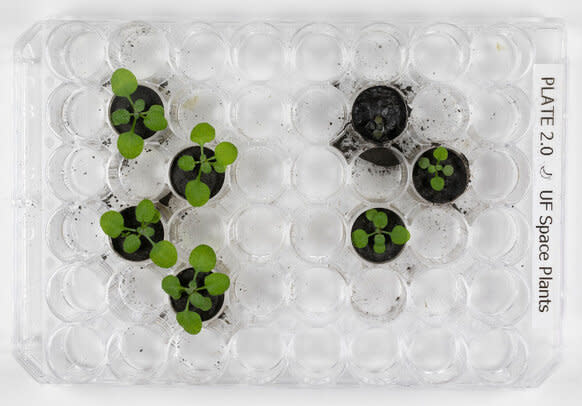Lunar horticulture: Plants grown in lunar “soil” for the first time
For the first time, scientists have grown plants in lunar regolith, the mixture of rock and dust that covers the surface of the Moon*.
This is very cool.
Regolith is nasty stuff. It’s made of pretty fine grains of rock that have broken down, eroded by micrometeorite impacts on the Moon as well as cracking under thermal stress from the huge swing in temperature from day to night, which changes by over 200° C. It’s very similar to volcanic ash. Under a microscope, regolith is a horror show, the grains all jagged and sharp-edged. It can get in machinery and cause damage, and if breathed in it mixes with mucus to become extremely irritating, causing coughing and sore throats.
But it has its uses. Lifting material from Earth to the Moon is very intensive in terms of fuel and money, so it makes sense to look into using whatever materials exist in situ. NASA and ESA are looking into using regolith to make building materials, for example.
And in fact astronauts have this annoying desire to be able to breathe and eat, so growing plants on the Moon is an area of study right now, especially with the lunar Artemis program starting to get going.
Regolith is everywhere on the Moon, so using it as a substrate to grow plants is worth investigating**. The problem is getting it: The Apollo astronauts only brought 360 kilograms of material back from the Moon, and the majority of that is rocks; only a fraction is actual regolith. NASA has been understandably stingy with releasing samples, especially for studies that will change the samples chemically.

A scientist carefully measures out a small amount of lunar regolith to be used to grow a plant. Note the gray color; the Moon’s surface is actually quite dark. Photo: UF/IFAS photo by Tyler Jones
Still, after many attempts to obtain samples, scientists from the University of Florida Space Plants Lab — an objectively cool name — convinced NASA to send them some. They got samples from Apollos 11, 12, and 17 totaling a mere 12 grams — less than half an ounce. But it was enough to start testing [link to paper].
The goal is not just to see if plants can be grown in regolith, but also to see what effects the weird stuff has on the plants and how that will affect future attempts to grow them on the Moon. Robert Ferl, a planet molecular biologist and one of the scientists performing the experiment, said something that struck me: “…what happens when you grow plants in lunar soil, something that is totally outside of a plant’s evolutionary experience?” We have the same issues with humans adapting to lunar gravity, for example. We didn’t evolve for such an environment, so what are the long-term effects?

A scientist harvests one of the cress plants grown in lunar regolith for genetic testing. Photo: UF/IFAS photo by Tyler Jones
They used seeds from the plant Arabidopsis thaliana, or thale cress, which biologists love. It’s very common, and has had its genome completely mapped, making it great for testing; the genetic code can be investigated before and after testing to see if there were changes and what they might mean.
Distributing the regolith in tiny thimble-sized wells in plastic, they added water, nutrients, and seeds. To their surprise, most of the plants germinated and even grew.
That right away is an interesting result, and worth follow-up, since it shows the regolith doesn’t overly interfere with the plant hormones that induce growth. But what they also found is that many of the cress plants were smaller and grew more slowly than seeds planted in a control group that used a mix of materials that just simulates regolith.
As someone married to a woman who is a landscape designer and has a very green thumb, I know that’s a sign of physical distress typically caused by environmental factors. When the scientists examined the plants’ genome, they found markers typical of stress induced by the plant dealing with things like salts, metals, and oxidizing compounds that interfere with the usual biological chemical balance.

Plants grown in lunar regolith (right) struggled and grow more slowly than plants grown in a control group (left). Photo: UF/IFAS photo by Tyler Jones
That’s incredibly useful information, since it gives biologists a place to work from to help the plants grow better. But they also found something else very interesting: They used samples of regolith from different Apollo missions, and material that was near the lunar surface and exposed long-term to space — and therefore cosmic rays, tiny subatomic particles zipping through space at high speed which can alter the chemistry of minerals — put more stress on the plants than more protected regolith. That’s another big help in understanding why the plants didn’t grow as well and may be important when astronauts on the Moon collect regolith for use.
And there will come a day, almost certainly not too far in the future, when that will happen. There is a vast amount of scientific knowledge to be gleaned by going back to the Moon and establishing a permanent presence there. Even as rocket flights get cheaper and easier there is still a lot to be gained by using materials from the Moon itself instead of hauling them up the gravity well, and the only way to find out is to go there and stay there. Live there.
To do that we have to understand as much as we can now, by studying the Moon here on Earth. Growing plants in the lunar regolith is an important step toward that future.
* There is some evidence that plants were grown from regolith before, but the pedigree of the story is spotty and not confirmed. My thanks to my friend Zach Weinersmith for pointing that out.
** A lot of people call this material “lunar soil,” a term I dislike; soil is dirt mixed with water and organic substances, and regolith is very different. I get why the term is used, but I prefer to differentiate the two.


